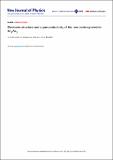Files in this item
Electronic structure and superconductivity of the non-centrosymmetric Sn4As3
Item metadata
| dc.contributor.author | De Almeida Marques, Carolina | |
| dc.contributor.author | Neat, Matthew James | |
| dc.contributor.author | Yim, Chi Ming | |
| dc.contributor.author | Watson, Matthew David | |
| dc.contributor.author | Rhodes, Luke Charles | |
| dc.contributor.author | Heil, Christoph | |
| dc.contributor.author | Pervakov, Kirill | |
| dc.contributor.author | Vlasenko, Vladimir | |
| dc.contributor.author | Pudalov, Vladimir | |
| dc.contributor.author | Muratov, Andrei | |
| dc.contributor.author | Kim, Timur | |
| dc.contributor.author | Wahl, Peter | |
| dc.date.accessioned | 2020-06-26T15:30:15Z | |
| dc.date.available | 2020-06-26T15:30:15Z | |
| dc.date.issued | 2020-06-24 | |
| dc.identifier | 267322543 | |
| dc.identifier | fa3460bd-feed-406e-95b7-744770eb65c7 | |
| dc.identifier | 85088873462 | |
| dc.identifier | 000545703500001 | |
| dc.identifier.citation | De Almeida Marques , C , Neat , M J , Yim , C M , Watson , M D , Rhodes , L C , Heil , C , Pervakov , K , Vlasenko , V , Pudalov , V , Muratov , A , Kim , T & Wahl , P 2020 , ' Electronic structure and superconductivity of the non-centrosymmetric Sn 4 As 3 ' , New Journal of Physics , vol. 22 , 063049 . https://doi.org/10.1088/1367-2630/ab890a | en |
| dc.identifier.issn | 1367-2630 | |
| dc.identifier.other | ORCID: /0000-0002-8635-1519/work/76386985 | |
| dc.identifier.other | ORCID: /0000-0003-2468-4059/work/76387206 | |
| dc.identifier.other | ORCID: /0000-0002-0737-2814/work/76387218 | |
| dc.identifier.uri | https://hdl.handle.net/10023/20163 | |
| dc.description | CAM and MJN acknowledge studentship funding from EPSRC under Grant no. EP/L015110/1. CMY and PW acknowledge funding through EP/S005005/1. CH acknowledges support by the Austrian Science Fund (FWF) Project No. P32144-N36 and the VSC-3 of the Vienna University of Technology. KSP, VAV, VMP, and AVM acknowledge support of the state assignment of the Ministry of Science and Higher Education of the Russian Federation (Project No. 0023-2019-0005). | en |
| dc.description.abstract | In a superconductor that lacks inversion symmetry, the spatial part of the Cooper pair wave function has a reduced symmetry, allowing for the mixing of spin-singlet and spin-triplet Cooper pairing channels and thus providing a pathway to a non-trivial superconducting state. Materials with a non-centrosymmetric crystal structure and with strong spin-orbit coupling are a platform to realize these possibilities. Here, we report the synthesis and characterisation of high quality crystals of Sn4As3, with non-centrosymmetric unit cell (R3m). We have characterised the normal and superconducting state using a range of methods. Angle-resolved photoemission spectroscopy shows a multiband Fermi surface and the presence of two surface states, confirmed by Density-functional theory calculations. Specific heat measurements reveal a superconducting critical temperature of Tc ∼ 1.14 K and an upper critical magnetic field of Hc ≈ 7 mT, which are both confirmed by ultra-low temperature scanning tunneling microscopy and spectroscopy. Scanning tunneling spectroscopy shows a fully formed superconducting gap, consistent with conventional s-wave superconductivity. | |
| dc.format.extent | 11 | |
| dc.format.extent | 2611494 | |
| dc.language.iso | eng | |
| dc.relation.ispartof | New Journal of Physics | en |
| dc.subject | Non-centrosymmetric | en |
| dc.subject | Superconductivity | en |
| dc.subject | Sn4As3 | en |
| dc.subject | Scanning tunneling microscopy and spectroscopy | en |
| dc.subject | Angle-resolved photoemission spectroscopy | en |
| dc.subject | QC Physics | en |
| dc.subject | DAS | en |
| dc.subject.lcc | QC | en |
| dc.title | Electronic structure and superconductivity of the non-centrosymmetric Sn4As3 | en |
| dc.type | Journal article | en |
| dc.contributor.sponsor | EPSRC | en |
| dc.contributor.sponsor | EPSRC | en |
| dc.contributor.institution | University of St Andrews. School of Physics and Astronomy | en |
| dc.identifier.doi | https://doi.org/10.1088/1367-2630/ab890a | |
| dc.description.status | Peer reviewed | en |
| dc.date.embargoedUntil | 2020-06-24 | |
| dc.identifier.grantnumber | EP/L015110/1 | en |
| dc.identifier.grantnumber | EP/S005005/1 | en |
This item appears in the following Collection(s)
Items in the St Andrews Research Repository are protected by copyright, with all rights reserved, unless otherwise indicated.

